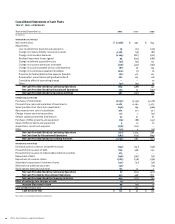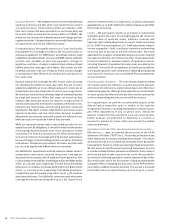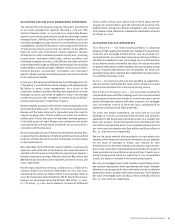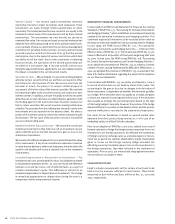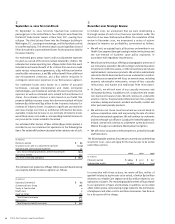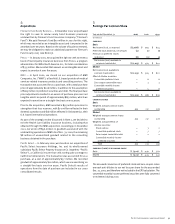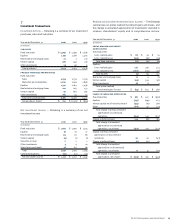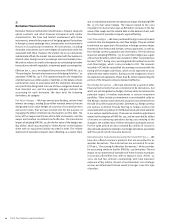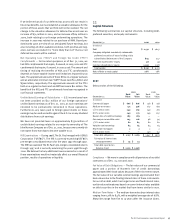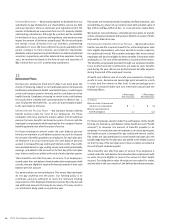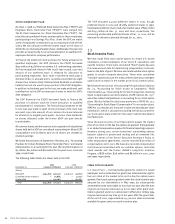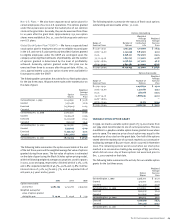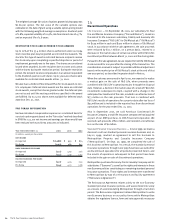Travelers 2001 Annual Report Download - page 56
Download and view the complete annual report
Please find page 56 of the 2001 Travelers annual report below. You can navigate through the pages in the report by either clicking on the pages listed below, or by using the keyword search tool below to find specific information within the annual report.
The St. Paul Companies 2001 Annual Report54
8
Derivative Financial Instruments
Derivative financial instruments include futures, forward, swap and
option contracts and other financial instruments with similar
characteristics. We have had limited involvement with these
instruments, primarily for purposes of hedging against fluctuations
in foreign currency exchange rates, interest rates and movement in
the price of a particular investment. All investments, including
derivative instruments, have some degree of market and credit risk
associated with them. However, the market risk on our derivatives
substantially offsets the market risk associated with fluctuations in
interest rates, foreign currency exchange rates and market prices.
We seek to reduce our credit risk exposure by conducting derivative
transactions only with reputable, investment-grade counterparties.
Effective Jan. 1, 2001, we adopted the provisions of SFAS No. 133,
“Accounting for Derivative Instruments and Hedging Activities,” as
amended (“SFAS No. 133”). The statement requires the recognition
of all derivatives as either assets or liabilities on the balance sheet,
carried at fair value. In accordance with the statement, derivatives
are specifically designated into one of three categories based on
their intended use, and the applicable category dictates the
accounting for each derivative. We have held the following
derivatives, by category.
Fair Value Hedges — We have several pay-floating, receive-fixed
interest rate swaps, totaling $230 million notional amount, that are
designated as fair value hedges of a portion of our medium-term
and senior notes, that we have entered into for the purpose of
managing the effect of interest rate fluctuations on this debt. The
terms of the swaps match those of the debt instruments, and the
swaps are therefore considered 100% effective. The transitional
impact of adopting SFAS No. 133 for the fair value of the hedges was
$15 million, which was recorded in “Other Assets” on the balance
sheet with an equivalent liability recorded in debt. The related
statement of operations impacts were offsetting; as a result, there
was no transitional statement of operations impact of adopting SFAS
No. 133 for fair value hedges. The impact related to the 2001
movement in interest rates was an $8 million increase in the fair
value of the swaps and the related debt on the balance sheet, with
the statement of operations impacts again offsetting.
Cash Flow Hedges — We have purchased foreign currency forward
contracts that are designated as cash flow hedges. They are utilized
to minimize our exposure to fluctuations in foreign currency values
that result from forecasted foreign currency payments, as well as
from foreign currency payables and receivables. The transitional
impact of adopting SFAS No. 133 for cash flow hedges was a gain
of less than $1 million, which was included in Other Comprehensive
Income (“OCI”). During 2001, we recognized a $2 million loss on the
cash flow hedges, which is also included in OCI. The amounts
included in OCI will be reclassified into earnings concurrent with the
timing of the hedged cash flows, which is not expected to occur
within the next twelve months. During 2001 we recognized a loss in
the statement of operations of less than $1 million representing the
portion of the forward contracts deemed ineffective.
Non-Hedge Derivatives — We have entered into a variety of other
financial instruments that are considered to be derivatives, but
which are not designated as hedges, that we utilize to minimize the
potential impact of market movements in certain investment
portfolios. These include our investment in an embedded collar on
Old Mutual common stock received as partial consideration from
the sale of our life insurance business (see Note 15), foreign currency
put options on British Pounds Sterling to hedge currency risk
associated with our position in Old Mutual stock and stock warrants
in our venture capital business. There was no transition adjustment
related to the adoption of SFAS No. 133, and we recorded $3 million
of income in continuing operations during 2001 relating to the
change in the market value of these derivatives during the period.
For the same period we also recorded $17 million of income in
discontinued operations relating to non-hedge derivatives associated
with the sale of our life insurance business.
Derivative-type Instruments Accounted for Under EITF 99-2 — We
have also offered insurance products that are accounted for as
weather derivatives. These derivatives are accounted for under
EITF 99-2, “Accounting for Weather Derivatives,” which provides
for accounting similar to that for SFAS No. 133 derivatives. The net
impact to our statement of operations of these insurance products
in 2001 was a $2 million loss, with no impact in 2000. At Dec. 31,
2001, we had two contracts outstanding, with total maximum
exposure of $15 million. As part of our December 2001 strategic
review, we determined that we would no longer issue this type
of product.


